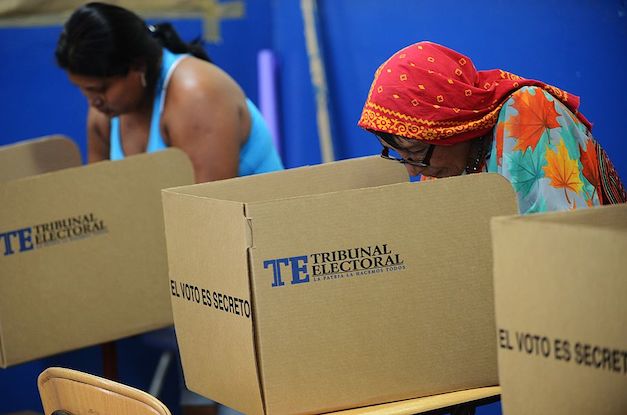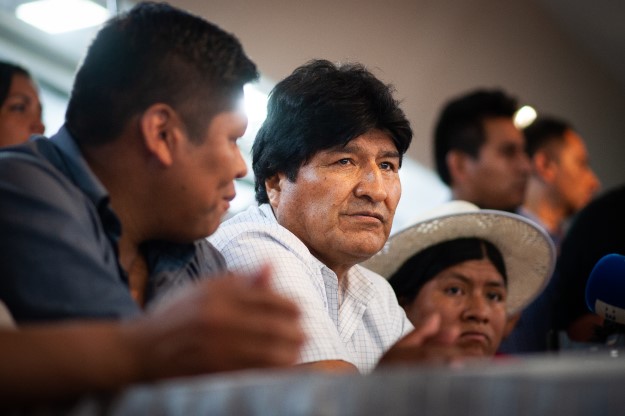Check out AQ’s full breakdown of the candidates in this year’s presidential elections in Argentina, Bolivia, Guatemala, Panama and Uruguay.
Corruption will be top of mind for many Panamanians when they head to polls to elect a new president on May 5. Almost three years removed from the release of the Panama Papers, the country has yet to fully ward off its reputation as a money-laundering paradise. Voters are eager for a clean-up, and the candidates have taken note – using televised debates mostly as opportunities to trade graft allegations.
Whoever wins on Sunday will be expected to continue President Juan Carlos Varela’s attempted overhaul of Panama’s public image. But the challenges from abroad may be even more consequential. Here are five things to know about Panama’s May 5 presidential election.
The candidates have little to argue about
In contrast to polarizing recent elections in Mexico, Brazil and elsewhere in the region, the candidates in Panama’s presidential vote share a similar worldview.
“Among the four candidates that lead the polls, it’s hard to think of a single substantive policy difference between them,” Eduardo Quirós, publisher of newspaper La Estrella de Panamá, told AQ. “Panamanians have always been very cosmopolitan, they understand that prosperity is linked to trade and open relations with the rest of the world and they have always avoided political extremes.”
Apart from trade unionist Saúl Mendez, the leading candidates are all center-right and pro-business. Laurentino “Nito” Cortizo of the Democratic Revolutionary Party (PRD) has a healthy lead in the polls, ahead of José Isabel Blandón of the ruling Panameñista Party and Romulo Roux, representing the Democratic Change (CD) party. There is no second round run-off, so the candidate with the most votes on Sunday will be named president.
Corruption allegations abound
With scarcely any daylight between their proposals on healthcare, education and pension systems, the candidates have homed in on corruption-busting as a winning issue.
Local prosecutors say that Odebrecht – the Brazilian construction firm at the center of a continent-wide graft investigation – paid over $100 million in bribes in Panama over the last 15 years. The majority of those kickbacks occurred during the presidency of Ricardo Martinelli (2009-2014) – currently in jail for wiretapping political opponents and journalists – and his party’s candidate, Roux, has had an investigation against him suspended while he runs for office.
Meanwhile Blandón has repeatedly tried to distance himself from Varela – recipient of $700,000 in campaign donations from Odebrecht, via a third party, in 2009. Blandón admits that, as mayor of Panama City, he awarded a $100 million contract to the Brazilian firm in full knowledge of the accusations against it. In November he made a telling Freudian slip, telling the press: “All the presidential campaigns received bribes … sorry, donations from Odebrecht.”
Cortizo has freely scored points off of his main opponents, but not because his party is beyond reproach. The PRD was out of power during the decade of the Brazilian bribe bonanza, so memories of the party’s own history of corruption are less fresh in the public mind.
China is conspicuously absent from the debate
One of the most important issues facing Panama has barely been discussed during the campaign: the country’s burgeoning diplomatic and economic ties with China. Since Varela’s surprise move to end his country’s longstanding relationship with Taiwan in favor of establishing formal ties with Beijing in June 2017, the two nations have signed dozens of bilateral agreements, with a free trade deal to follow shortly. However, Panama is of strategic and symbolic importance to the U.S. and serious pushback from Washington seems inevitable.
“The government has put Panama in the midst of the world’s biggest geopolitical rivalry: the trade war between the U.S. and China,” Carlos Guevara Mann, an associate professor in political science at Florida State University’s Panama campus, told AQ.
The winner may have little room to maneuver beyond diplomatic talks with Washington. Chinese firms are already building major infrastructure projects and in March China Railway Design presented a self-funded feasibility study for a $4 billion high-speed train from Panama City to the Costa Rican border. Panama’s geographic location and canal make it a natural destination for Belt and Road Initiative funding, and technology firm Huawei has established a distribution hub in the Colón Free Trade Zone.
The Panama Papers are still having an effect
China is also a source of investment that Panama’s new president won’t be able to ignore. Following years of record growth spurred by the expansion of the canal, the economy faltered under Varela, who was frequently portrayed as a tortoise by the nation’s cartoonists.
Varela had to pick up the tab for many of his predecessor’s infrastructure projects and deal with the fallout from the Panama Papers scandal, which broke in April 2016. The leaking of millions of documents from local law firm Mossack-Fonseca shed light on a global network of financial crime and tax-evasion, but Panama paid the highest reputational price. The inclusion of the country in a number of “grey-lists” for money-laundering and tax evasion led to higher compliance costs and resulted in many international banks cutting their ties with Panamanian counterparts. The financial and legal services sector and the construction industry, two pillars of the economy, slumped.
New electoral rules may signal change
Panama also has its “outsider” in this race. Ricardo Lombana, a 45-year-old former journalist with a strong social media presence, has risen to third place in many polls. Lombana’s candidacy benefited from changes in election rules. For much of the last 40 years – before the arrival of the CD party – power alternated between the PRD and Panameñista parties. However, the power of political parties appears to have been eroded by changes introduced this year that limit the campaign period to 60 days and prohibit private financing of advertising.
“We’ve seen the independent vote rise from virtually nothing five years ago to over 15%-20% today. We could be seeing the breaking point of the historical party system,” said Quirós.
—
Youkee is a journalist based in Bogotá. Follow him on Twitter @matyoukee








